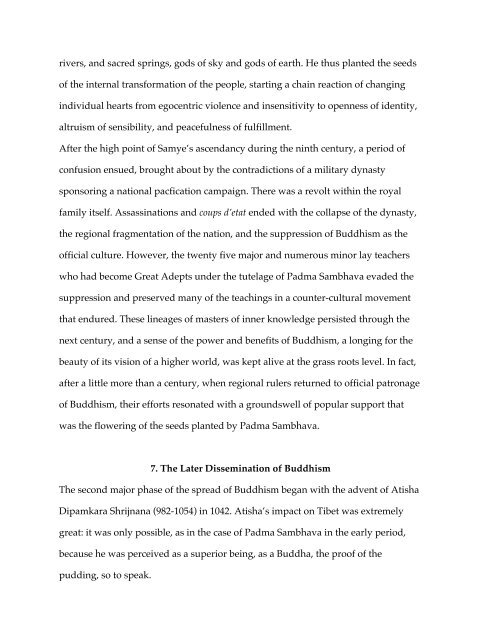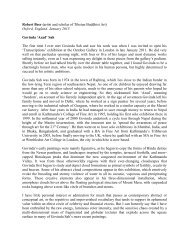Thurman, Essential Tibetan Buddhism Introduction (part) - Tibet House
Thurman, Essential Tibetan Buddhism Introduction (part) - Tibet House
Thurman, Essential Tibetan Buddhism Introduction (part) - Tibet House
Create successful ePaper yourself
Turn your PDF publications into a flip-book with our unique Google optimized e-Paper software.
ivers, and sacred springs, gods of sky and gods of earth. He thus planted the seeds<br />
of the internal transformation of the people, starting a chain reaction of changing<br />
individual hearts from egocentric violence and insensitivity to openness of identity,<br />
altruism of sensibility, and peacefulness of fulfillment.<br />
After the high point of Samye’s ascendancy during the ninth century, a period of<br />
confusion ensued, brought about by the contradictions of a military dynasty<br />
sponsoring a national pacfication campaign. There was a revolt within the royal<br />
family itself. Assassinations and coups d’etat ended with the collapse of the dynasty,<br />
the regional fragmentation of the nation, and the suppression of <strong>Buddhism</strong> as the<br />
official culture. However, the twenty five major and numerous minor lay teachers<br />
who had become Great Adepts under the tutelage of Padma Sambhava evaded the<br />
suppression and preserved many of the teachings in a counter-cultural movement<br />
that endured. These lineages of masters of inner knowledge persisted through the<br />
next century, and a sense of the power and benefits of <strong>Buddhism</strong>, a longing for the<br />
beauty of its vision of a higher world, was kept alive at the grass roots level. In fact,<br />
after a little more than a century, when regional rulers returned to official patronage<br />
of <strong>Buddhism</strong>, their efforts resonated with a groundswell of popular support that<br />
was the flowering of the seeds planted by Padma Sambhava.<br />
7. The Later Dissemination of <strong>Buddhism</strong><br />
The second major phase of the spread of <strong>Buddhism</strong> began with the advent of Atisha<br />
Dipamkara Shrijnana (982-1054) in 1042. Atisha’s impact on <strong>Tibet</strong> was extremely<br />
great: it was only possible, as in the case of Padma Sambhava in the early period,<br />
because he was perceived as a superior being, as a Buddha, the proof of the<br />
pudding, so to speak.





